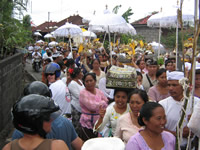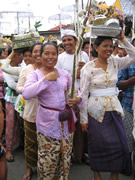 Traffic jams are usually not fun and living in Seminyak Bali traffic jams are getting to be normal. Anyone who has tried to get from Kuta to Jl. Dhyana Pura recently will know what I’m talking about. One type of traffic jam that I don’t mind getting stuck in is a Balinese ceremonial procession. Today in Kerobokan my friends and I ran into a large funeral procession that demanded attention. It also demanded we stop moving for around 10 minutes and enjoy the view.
Traffic jams are usually not fun and living in Seminyak Bali traffic jams are getting to be normal. Anyone who has tried to get from Kuta to Jl. Dhyana Pura recently will know what I’m talking about. One type of traffic jam that I don’t mind getting stuck in is a Balinese ceremonial procession. Today in Kerobokan my friends and I ran into a large funeral procession that demanded attention. It also demanded we stop moving for around 10 minutes and enjoy the view.
Checking out a house for sale down a local street, we were surrounded by the slow moving funeral procession and forced to pull over and sit patiently as it moved by. Locals were in good spirits and liked having their photo taken. Today was slighlty overcast, which I’m sure the Balinese ladies were glad about. Having to march for a hour or so in the blazing sun, without a hat is no fun and they will often use a newspaper to shield their faces.
Today Balinese women passed us with trays and baskets of offerings on their heads, while men and women carried tall white umbrellas. Hundreds of people passed by and the deceased must of been an important person.
 Balinese Hindu’s believe that the human body is only a temporary residence for the soul, during its time on Earth. After death the body must be ritually broken down into its basic elements which are solid, liquid, energy, radiance and ether. A Balinese man must start saving for the cremation of his father, long before his death. When the father dies there will be a ceremony and the body is buried at the local graveyard, in preparation for the cremation ceremony which may be years away. During a cremation ceremony the whole village turns out an there are many important rituals that have to be undetaken.
Balinese Hindu’s believe that the human body is only a temporary residence for the soul, during its time on Earth. After death the body must be ritually broken down into its basic elements which are solid, liquid, energy, radiance and ether. A Balinese man must start saving for the cremation of his father, long before his death. When the father dies there will be a ceremony and the body is buried at the local graveyard, in preparation for the cremation ceremony which may be years away. During a cremation ceremony the whole village turns out an there are many important rituals that have to be undetaken.
During a cremation ceremony (pengabenan or palebonan) the body rests in the base of the tall cremation tower, which is a lightweight structure built on a bamboo frame, in order to be carried by a dozen men. This together with the sarcophagus, often times a bull, are taken to the Pura Dalem, or temple of the dead, where the body will be transferred to the sarcophagus and set ablaze. Today we did not see the cremation tower, the procession having already moved along, but it was nice to be surrouned by the people’s energy.
After a ceremation has taken place another important ceremony (nyagara-gunung) is performed at the beach, where the ashes are dispersed in the ocean and also at mountain temples. One will often observe the son of the deceased being escorted down to the waters edge where he bursts into tears, sagging and flayling dramatically, before being helped away again. This is expected and part of the deal.